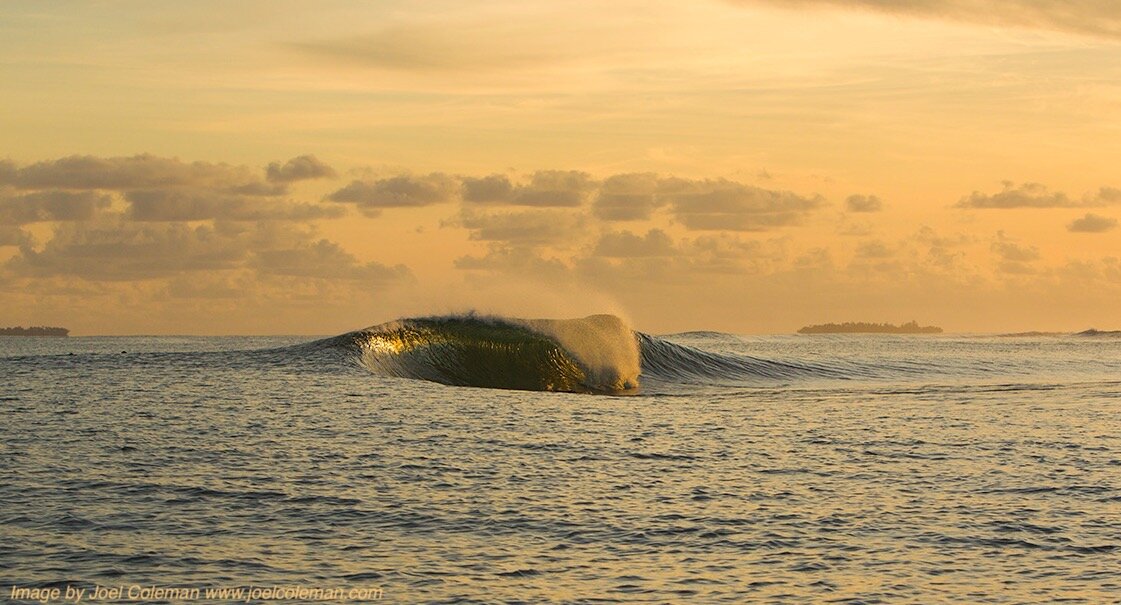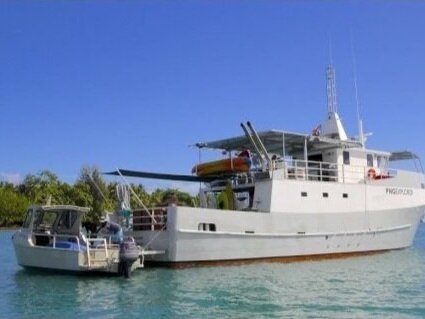
surf
new ireland is located just a couple of degrees south of the equator, and during the northern hemisphere monsoon, the north coast and the string of island leading to the west, enjoy uninterrupted North Pacific Ocean swells, ideal for surfing.
The peak surf season extends from November through late April.
surfing in new ireland
For most, Papua New Guinea is not a well-known destination for surfing, however people have been surfing here for hundreds of years. New Ireland has become known to travelling surfers only over the last 20 years, with the opening of Nusa Island Retreat who were the first to promote surfing and cater for travelling surfers in and around the Kavieng area.
New Ireland Province offers a very healthy range of Surfing possibilities for the adventurous surfer. Best identified nowadays, is the northern end of mainland New Ireland around the Kavieng area, extending out into the Tigak Islands, then further west to Lavongai (New Hanover), as well as down along the Boluminski Hwy on east coast of mainland New Ireland. Other island groups are also being identified with great new surfing possibilities emerging.
While many international surf destinations rapidly pass through stages of initial discovery and early years of limited exposure and exploitation; all too often the once pristine surf destination quickly becomes over exposed, over exploited and over crowded. The magic is lost as the resort operators & tour operators quickly take control, resulting in overcrowding and over development with the primary goal becoming profit generation for the operators..
surf management plans
Fortunately, PNG has had the foresight to observe and identify the many shortcomings of over-commercialisation of surf resources in various other mainstream locations. The Surfing Association of Papua New Guinea, its Clubs, Resource Communities and ultimately the commercial tour and service operators have necessarily aligned and agreed to the establishment of Surf Management Plans in order to promote sustainable growth of surf tourism in line with agreed expectations and benefits at each level of the PNG Surf movement.
The Kavieng Surf Club was established in 2003 and developed the Kavieng Surf Management Plan, with the Central New Ireland Surf Club following suit in 2006. Due to the steady growth of surfing in other areas of New Ireland, a plan of action needed to be in place to protect surfing both as an industry and a sport. This saw the founding of the Niu Ailan Surfriders Alliance (NASA) in 2007, which was tasked to promote sustainable development of surfing in all of New Ireland - primarily to develop, manage and oversee Surf Management Plans. The Lavongai and the East Coast Management Plans were then established.
kavieng
The Niu Ailan Surfriders Alliance (NASA) & the Kavieng Surf Club manage and oversee the Kavieng Area Surf Management Plan, essentially a surf quota system which limits the number of visiting surfers to 20 per day. This limit is for the whole Kavieng area, regardless of where the surfers stay, with prescribed base fees generated and dispersed between the KSC, SAPNG, and the resident communities adjacent the resource. Please visit the NASA website for information on how to book into the quota.
Kavieng and its environs form part of the Bismarck Archipelago, an extensive chain of islands with fringing coral reefs. Kavieng is reasonably well known for having access to a good range of quality left and right breaks in relatively close vicinity. All breaks are reef breaks, and vary in their degree of difficulty, depending on the size and direction of the swell, and the depth of the reef. A surfer's paradise with consistent swells between 3 - 5 foot, getting up to 6-8 foot and sometimes bigger. All breaks can be surfed on most tides and the set ups vary depending on conditions.
pikininis
Extremely fast, heavy barreling, very shallow right-hand coral reef break. Given the right conditions and swell direction, the waves can peel for up to 200m. Works best on a low to mid-tide, with a west to north-west swell direction. A mini Kirra. Reef boots are a must. .
Ral island
A small, uninhabited island situated further out to sea. A great place to go if there is no swell anywhere else, Ral attracts more swell than the other breaks in the region. Best surfed on small, clean swells, the right-hander can at times be peaky like a beach break, and sometimes can line up like a point break. The left is not as consistent as the right, but worth checking. Both waves pack a bit of punch once the wave height gets bigger. Ral can also handle more surfers than most of the other breaks.
long longs
A right-hander, good on a big swell. Works best on a mid-tide with a north wind. Long Long is a more forgiving wave than most of the other reef breaks. The water is deeper and long rides, with a nice wall, ending with a hollow bowl section can be had. Good for long boards and mid size fish fun boards and twin fins.
nago island
This picturesque little island has both a left and right-hander. The left-hander is a bit of a wave magnet and very consistent. A great hotdog, fun wave that has a nice tubing inside wall section. Likes low to mid-tide as it can be a bit fat and break too close to the inside ledge on high tide. It does not like too much swell, but can still be fun on a light onshore. This is one of the most surfed breaks in the area. The right-hander on the other side of the island has a very fast, long wall. It likes a mid to low tide, is a little inconsistent, but a great ride when it’s on. Keep an eye on this break when the swell comes up.
nusa lefts
Nusa Left is a fast breaking, very reliable barreling left-hander that jacks up out of deep water, with a very shallow end section. It works best on mid to low-tide with a westerly swell direction and an easterly wind. Keep an eye on the outside bomby - this can also be ridden on the right conditions.
edmago island
Edmago is a smaller island situated southwest of Nago, in between Nago and Ral. It has a very good quality left-hander, given the right swell and wind direction and is best at mid-tide. The right-hander is also best at mid-tide and can pick up more swell than the left.
east coast new ireland
The defined East Coast Surf Area commences southeast of Kavieng, at North Cape, and extends to the south side of Konos Village (145km from Kavieng). It includes all surf breaks that occur regularly or from time to time along the entire stretch of coast.
The quota for the East Coast Surf Managed Area is 25 visiting surfers.
CENTRAL NEW IRELAND
The Central New Ireland Surf Club in cooperation with the Niu Ailan Surfriders Alliance and the Surfing Association of Papua New Guinea has established the Central New Ireland Surf Management Plan to benefit both the incoming surf tourist and the traditional resource custodians. The plan ensures the incoming surf tourist that there will only be a maximum of 20 international surfers at any time surfing within the managed area. The plan ensures the traditional resource custodians that there are real benefits from tourism flowing into their communities. The plan also ensures that surf tourism is sustainable in our region.
The Central New Ireland Surf Management Plan commences from where the East Coast Plan finishes after Konos and extends to Ramat (20km north of Namatanai). Please visit the NASA website for information on how to book into the quota.
Surf spots range from mellow longboard waves to fast and hollow reef passes. There are both rights and lefts and are open to many swell directions.
Surf Season is from mid-October to mid-May.
lavongai (new hanover)
To the west of Kavieng extends the Bismarck Archipelago, with over a hundred islands extending out to Lavongai which has heaps of uncrowded reef breaks with plenty of variety. The islands of this area are spectacular with friendly communities, and the beautiful backdrop of Lavongai’s mountains in the distance, make it a stunningly beautiful destination.
The Lavongai Surf Managed Area starts where the Kavieng Area finishes at Ral Island and extends to the north coasts of Lavongai and its offshore islands.
The quota for the Lavongai Surf Managed Area is 15 visiting surfers.
Please visit the NASA website for information on how to book into the quota.
where to stay
The operators below are affiliated with the TPA-endorsed Surfing Association of Papua New Guinea, and will automatically book you into the relevant Surf Management Plan for your surf trip. These operations are run by surfers, and cater specifically to surfers.
There are also many many more places to stay, and for you to explore the surf breaks on your own. For all other accommodation facilities, visit our Places to Stay page.











